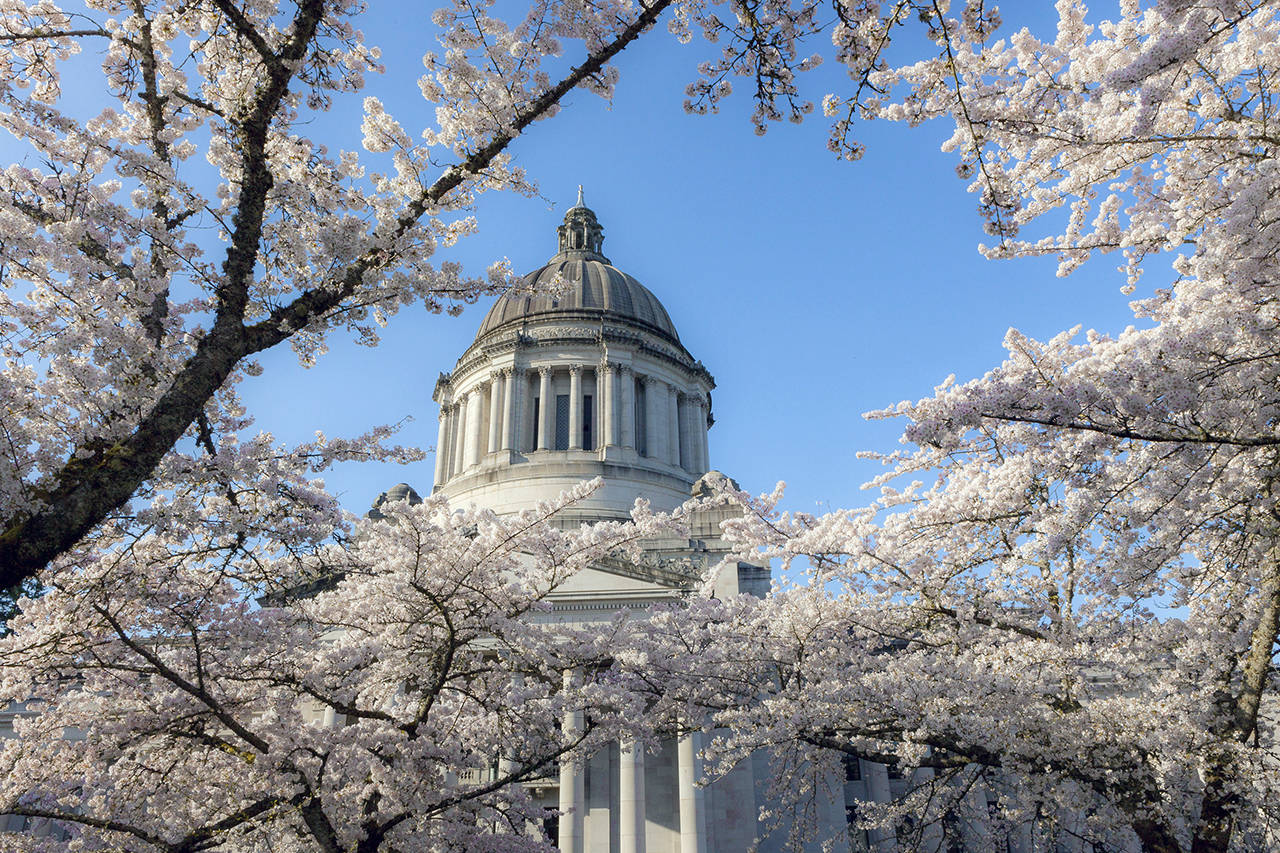By Katie Lutz
WSU Master Gardener
Timberland Regional Libraries recently purchased “The Sakura Obsession,” by Naoko Abe. It tells the story of a British plant collector and gardener Charles “Cherry” Collingwood, who returned from England from his honeymoon in Japan in 1907 with hundreds of cherry tree cuttings. One of these was a variety nearly extinct in Japan, the “Great White Cherry.” A living cutting, grown by Collingwood in a potato, was sent to Japan and was successfully reintroduced to that country.
Intrigued by this discovery, I thought to learn more about cherry blossoms. Though many other plants alert us that spring has sprung — daffodils, snow drops, hyacinths — there is something quite majestic about the soft cloud of blossoms that cover these cherry trees for such a short amount of time.
We are in the midst of peak bloom for cherry blossoms all over the world. In the United States, the Cherry Blossom Festival in Washington, D.C., drew upwards of 1.5 million people earlier this month.
Japanese cherry blossoms belong to the genus Prunus, home of the stone fruits. In addition to cherries, fruit and nut trees such as plums, peaches, apricots and almonds fill its ranks. It’s important to note that there are two distinct groups within this genus: those that are grown for their fruit and those that are grown as ornamentals. Generally, the ornamentals produce fruit that is inedible for humans, if they even produce fruit at all.
Over 200 varieties of cherry trees can be found in Japan alone, although there are likely more as a result of inventive gardeners. You can find them in four main flower styles: the full and round standard upright, the delicate weepers, the cloudlike spreaders, and the columnar trees.
Ornamental flowering cherries require sun and fast-draining, well-aerated soils. They prefer a moderate amount of water, so they may do better here in a container pot or raised bed, depending on the microclimate and soil conditions of your property.
Adding to their ephemeral nature, cherry blossoms are susceptible to many diseases and pests. Of particular concern are bacterial blight and cherry brown rot, as well as several other types of fungi and a number of viruses. Aphids and caterpillars also seem to take particular joy in feeding on the leaves and inside the bark. It can make growing cherries for fruit a difficult endeavor, and unfortunately the ornamentals are also at risk. For the Pacific Northwest, the standard upright variety Prunus x yeodoensis “Akebono” is one of the best, most disease-free flowering cherries (according to Sunset magazine).
Beyond the botany and the beauty of the cherry blossom is also the cultural history that is tied with it. First off, the varieties of cherry blossoms that exist are partially due to the unique topography of Japan that created an ecosystem where cherries fitting so many niches could develop. Historically, they were also viewed as valuable plants to be saved, in part due to their cloudlike symbolism and associations with Buddhist thought. Some of the earliest evidence for observance of cherry blossoms date back to the 3rd century A.D. in Japan. More detailed records exist showing that the practice of “flower viewing” on a larger scale occurred as early as the 700s A.D.
However, this symbolism became subverted during the Imperial period leading up to and during World War II. The Cherry Blossom Society was founded as a secret society within the Japanese military to support more extreme militaristic views, and publicly the government used the symbolism of the short life of the cherry blossom to encourage soldiers to give their all in battle. Additionally, it was planted in places like China and Korea as a symbol of colonialism, which to this day sees citizens calling for these plants to be removed from certain public spaces.
Keep your eyes peeled at the library for “The Sakura Obsession.” And if you’d like to learn more about the botany of Japanese cherry blossoms, I found this legally free (as far as I can tell) version of Wybe Kuitert’s book “Japanese Flowering Cherries” here: www.issuu.com/jtvr/docs/japanese_flowering_cherries_by_wybe.
Katie Lutz, from Hoquiam, joined the WSU Master Gardener program in 2016. Be sure to visit the 2019 Grays Harbor Home and Garden Show, May 18-19. Free admission and parking.


